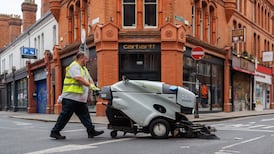House prices in Dublin have risen by almost 20 per cent since the beginning of the year, according to a survey published yesterday. But the rate of increase is showing signs of decreasing since the introduction of special Government measures last April.
The Minister for Finance, Mr McCreevy, said yesterday that he "took encouragement" from the results which, he said, represented evidence that the measures to slow down prices were having the desired effect.
The Institute of Professional Auctioneers and Valuers (IPAV), which carried out the survey covering the period from January 1st to July 31st last, said the Government measures had driven the majority of investors out of the housing market into other areas. But the IPAV warned that the same measures were causing "distortion" in the marketplace and could lead to a critical shortage of accommodation this autumn.
The IPAV Executive Secretary, Mr Liam O'Donnell, called on the Government to consider the phased re-introduction of tax incentives for private investors who provide good quality accommodation. "Using the taxation system as a `quick-fix' solution to the overall housing crisis is not the answer," he said.
Following the publication of the Bacon Report on house prices in April, the Government introduced measures designed to allow first-time buyers easier access to the market and to free up some second-hand homes for sale.
The measures included cuts in stamp duty, but with controls to ensure that investors would have to pay stamp duty on new homes. Since April, the Revenue Commissioners have also disallowed for tax purposes interest as an offset against rental income for residential property.
The IPAV estimated the measures had removed over one third of buyers from the market. The survey of 100 auctioneers showed a national average increase of 10 per cent in house prices since the beginning of the year, and a 20 per cent average increase in Dublin.
However, the rate of increase in house prices has fallen, as has the price of some second-hand apartments since the introduction of the Government measures.
Although the prices achieved for houses in Dublin continues to rise, the rate of increase has fallen by 75 per cent in some categories, according to the survey. The rate of price increase for houses valued between £100,000 and £170,000 has fallen during the past seven months from 16.9 per cent to 4.4 per cent while that for houses priced between £60,000 and £100,000 has dropped from 15.5 per cent to 5 per cent.
The survey also reveals a significant decline in the level of inquiries for investment houses since the Government measures were introduced. Inquiries in Dublin have fallen by as much as 50 per cent, while in Limerick they fell by 22 per cent, in Galway by 18 per cent and in Cork by four per cent.
"This level of decrease shows that the Government measures have had a real effect by driving the majority of investors out of the housing market and into other areas," according to IPAV president, Mr Ronald Duff. He said the effect was most evident in the sale of second-hand apartments which attracted many investors because of the ease of maintenance.
The IPAV said that other measures were also likely to have contributed to the decline in the rate of increase in house prices. It appeared prices had peaked as the majority of earners were unable to afford the cost of very high mortgages. According to the survey, houses and apartments were now taking a longer time to sell than in the early part of the year.
The survey also showed that rents had begun to rise rapidly as a result of the scarcity in housing units for letting. Rents in Dublin had already increased this year by up to 13 per cent and, according to the IPAV, were set to rise even more dramatically in the near future. Mr O'Donnell of IPAV warned the rental situation was likely to peak when students returned to college at the end of this month.
The survey found that land prices had continued to increase at a modest pace. The average increase in the price of land with quota was 6.9 per cent compared to 8.2 per cent for land without quota.
The IPAV said the figure was somewhat distorted by exceptionally large figures paid for land near Dublin. In Co Meath, the average increase in land prices was 25 per cent while in Co Kerry there was an average decrease of 0.8 per cent. The IPAV said much of the increase was caused by farm purchases by "hobby" farmers.
Reacting to the survey, Democratic Left Housing spokesman, Mr Eamon Gilmore, said the IPAV claim that the rate of increase in house prices was slowing down would be little comfort to the tens of thousands of families who had found themselves priced out of the housing market and unable to secure public housing because of the Government's failure to increase public housing numbers.
He said the IPAV view was at variance with figures published just two weeks ago by the Irish Permanent Building Society which found that prices rose by some 16 per cent in the first six months of this year. "The indisputable fact is that house prices are continuing to rise and houses that are already too expensive will remain outside the range of many low and middle income families unless more urgent action is taken to deal with the situation."
He called for a comprehensive statement of Government housing policy and said the public housing programme must be increased to reduce the numbers on local authority housing lists, estimated at 50,000.










